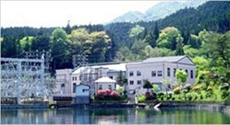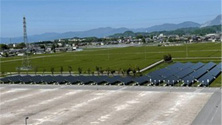Our Group has set “Contribution to realizing a carbon-free society” as a goal in our Environmental Vision 2050, aiming to achieve net-zero greenhouse gas emissions across the entire value chain.
Environmental Policy/Medium- to Long-term Vision and Targets
In our Environmental Targets 2030, we have set a target to reduce GHG emissions in order to contribute to carbon-free society. This target was obtained SBT 1.5℃ certification in July 2023.
●Greenhouse gas emissions from business activities (Scope 1 & Scope 2): Reduce by at least 42% compared with FY2021
●Greenhouse gas emissions in the value chain (Scope 3): Reduce by at least 25% compared with FY2021
Our Group is working to reduce greenhouse gas emissions from business activities (Scope 1&2), promote the use of renewable energy, enhance energy conservation at factories, and reduce CO₂ emissions in logistics. Additionally, we are implementing appropriate measures to address physical risks related to climate change, such as heavy rain. We will continue to pursue further reductions in greenhouse gas emissions.
In FY2024, the greenhouse gas emissions from our Group’s business activities totaled 417 thousand tons, with Scope 1 emissions at 108 thousand tons and Scope 2 emissions at 309 thousand tons, representing a 35% reduction compared with FY2021. Scope 1 emissions primarily consist of CO₂ from energy sources and sulfur hexafluoride (SF₆) used in high-voltage testing equipment. Additionally, greenhouse gas emissions in the value chain (Scope 3) are predominantly from Category 1 (“Purchased goods and services”) and Category 11 (“Use of sold products”). In FY2024, Scope 3 emissions totaled 4,087 thousand tons, a 9% reduction compared with FY2021.


*1 Emission factors for greenhouse gas calculations are based on the “List of Calculation Methods and Emission Factors for the Greenhouse Gas Emissions Calculation, Reporting, and Disclosure System” published by the Ministry of the Environment. Emission factors for purchased electricity overseas are based on data published by public institutions in each country.
*2 Greenhouse gas emissions other than CO₂ are converted to CO₂-equivalent emissions using the Global Warming Potential (GWP) values provided by the IPCC.
*3 Scope 3 emissions in the value chain are calculated in accordance with the “Basic Guidelines for Calculating Greenhouse Gas Emissions Through the Supply Chain” issued by the Ministry of the Environment and the Ministry of Economy, Trade and Industry. Some category emission factors refer to the LCI database “AIST-IDEA” developed by the National Institute of Advanced Industrial Science and Technology.
TOPICS "Copper alloy products/superconducting products manufactured with renewable energy"






Furukawa Electric Group's energy usage rate was about 20% for fuel and about 80% for electricity. We are promoting energy conservation in manufacturing processes with high energy usage ratios by improving process efficiency, upgrading to high-efficiency equipment, and implementing measures such as insulating high-temperature components of equipment to optimize energy balance. Additionally, we are systematically transitioning factory buildings and office lighting to LED. In FY2024, we implemented measures such as efficient heat utilization (e.g., waste heat recovery, operational reviews of heat treatment furnaces, and heat-insulating coatings), the introduction of high-efficiency equipment (e.g., operational reviews of air conditioning, and upgrades to air conditioners, motors, and transformers), and efficient equipment operation. As a result, total energy consumption in FY2024 was 278 thousand kL in crude oil equivalent, a 21% reduction compared with FY2020.

In FY2024, our transportation volume was 103 million ton-kilometers, a 13% reduction compared with FY2020, and CO₂ emissions decreased by 8% to 12.6 thousand t-CO₂e. However, the transportation energy intensity increased by 6% compared with FY2020. We will continue to promote modal shifts, improve loading efficiency, and advance joint delivery initiatives.

Internal carbon pricing (using a shadow price) has been calculated since FY 2019. By visualizing the amount of CO₂ emissions for each division using carbon prices, we encourage preparation to avoid climate change risks toward decarbonization. For example, a division that cannot meet its reduction target will have a negative shadow price and will incur a hypothetical loss. Conversely, a division that meets the target will have a positive shadow price and will bring hypothetical profit. Based on the quarterly evaluation and posting effects, a renewable energy introduction plan is promoted for any division that does not meet the target.
The Group takes appropriate management and preventive measures against physical risks related to climate change (heavy rain, heavy snow, etc.). Each works take measures for air-conditioning to cope with global warming. The following is initiatives Hiratsuka and Nikko Works have taken.
| Works | Target | Measures |
|---|---|---|
| Hiratsuka | heavy rain |
|
| Nikko | heavy snowfall |
|
Furukawa Electric Group participates in the following initiatives to realize a carbon-free society.
Our group companies located in Japan belong to two industry associations, the Japanese Electric Wire & Cable Makers' Association and Japan Copper and Brass Association. In the Carbon Neutral Action Plan of each association, we set targets for each association and work to ensure that our policies and strategies are consistent with those of the associations as a group.In the worst case scenario, the association's policies are significantly weaker or inconsistent with the Group's strategy, we will encourage the associations to align their policies with those of the Group. If such alignment is difficult, we will take appropriate action considering withdrawal from the associations.
To achieve our Environmental Vision 2050 and accelerate efforts to reduce greenhouse gas emissions, our Group has established Environmental Targets 2030. These targets align with the Japanese government’s “Plan for Global Warming Countermeasures” (revised in February 2025).
The Group has been responding to CDP's questionnaire on climate change, which represents institutional investors, since FY2008. In order to support customers making use of CDP supply chain programs, we participated in explanatory meetings and attended seminars. We will continue to expand the scope of environmental data we disclose and enhance our reliability.